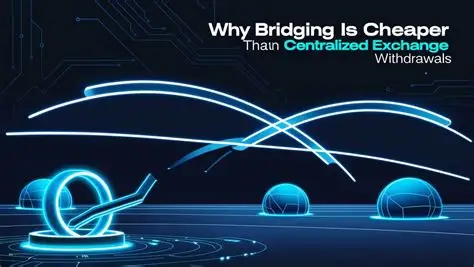In this blog, I will explain why Bridging Crypto Is Cheaper Than Centralized Exchange Withdrawals. With bridging, users can unlink assets across multiple blockchains and pay considerably less, provided they avoid the exorbitant fees charged by exchanges for withdrawals and conversions.
- Understanding Crypto Bridging
- Why Bridging Crypto Is Cheaper Than Centralized Exchange Withdrawals
- Lower Fees
- No Conversion Costs
- Faster Transactions
- Access to Cheaper DeFi
- Greater Flexibility
- Less Reliance on Centralized Platforms
- Transparent Transactions
- Centralized Exchange Withdrawals: How Costs Accumulate
- Cost Comparison: Bridging vs Centralized Exchange Withdrawals
- Additional Benefits of Bridging
- Faster Transactions
- Cheaper Costs
- Access to DeFi
- Cross-Chain Flexibility
- Less Reliance on Centralized Services
- Better Transparency
- Potential Risks to Consider
- Conclusion
- FAQ
In addition to the above, this method offers cheaper transactions, quicker transfer speeds, higher flexibility, and better savings from purchasing decentralized finance services compared to older, centralized methods.
Understanding Crypto Bridging
Transferring assets between chains is called crypto bridging. A form of a bridge is a decentralized protocol which facilitates the transfer of assets between blockchains. A bridge locks the original asset on its native chain and mints a clone on the destination chain.

If a user wants to transfer Ethereum from the Ethereum network to the Binance smart chain (BSC), the bridge Ethereum and a wrapped version of Ethereum (ETH) is provided on BSC. This bridging technique makes cross-chain functionality possible and helps users leverage and access DeFi applications on various blockchains.
Prominent bridges like Wormhole, AnySwap, and deBridge create reliable alternatives to centralised exchanges and provide dependable ways to transfer tokens across different networks. Unlike centralised exchanges, users of a bridge do not incur high withdrawal charges or other hidden fees. Instead, a user simply pays a network fee which is much lower than the fee charged by centralised exchanges.
Why Bridging Crypto Is Cheaper Than Centralized Exchange Withdrawals

Lower Fees
Bridges only charge a small network fee and do not charge high withdrawal and processing fees like centralized exchanges.
No Conversion Costs
Cross-chain transfers leave out token conversions before withdrawal, avoiding conversion fees.
Faster Transactions
Bridging, unlike CEX which is often delayed due to multiple confirmations or peak congestion, allows quicker transfers.
Access to Cheaper DeFi
Gas fees, and cheaper staking, lending, or yield farming are available on certain networks, which users can transfer assets to.
Greater Flexibility
Bridges provide access to varied lender and liquidity DeFi systems by permitting free asset transfers across multiple blockchains.
Less Reliance on Centralized Platforms
Bridges, unlike exchanges which are often down, limit withdrawals, or have other security issues, lessens the dependency on exchanges.
Transparent Transactions
Bridging provides on-chain transactions records, which is more reliable and better transparency compared to some exchange withdrawals.
Centralized Exchange Withdrawals: How Costs Accumulate
Centralized crypto exchanges (CEXs) such as Coinbase, Binance, and Kraken have made it easier to buy, sell, and store different kinds of cryptocurrencies. However, the profits seem to decrease as deposits profits more than withdraw. There are two main types of fees involved when withdrawing the funds.
Withdrawal Fees set by the Exchange: These fees are set by the platform for carrying out the withdrawal. Each exchange has a predetermined fee in USD and a varying fee for each cryptocurrency withdrawal. They can set a fixed fee or a percentage fee.
Network Fees (Blockchain Fees): The Ethereum and Bitcoin networks require fees for every transaction. The Ethereum and Bitcoin networks require fees for every transaction. Block miners or validators are paid by network fees for confirming the transfer. These fees, called network fees, can be steep in congested networks.
Cost Comparison: Bridging vs Centralized Exchange Withdrawals
Unlike withdrawing from Centralized Exchanges (CEXs), the bridging of crypto to other networks is instantly cheaper. Centralized Exchanges charge for withdrawals alongside the network gas fee, and sometimes even a ‘conversion fee’ if a token must be swapped before it can be withdrawn.
Conversely, crypto bridging services charge a token minting fee, which is indicative of a very low charge network fee for the target blockchain, thus crypto bridging is cheaper for cross-chain transfers.
Taking a closer look, withdrawing 1 ETH from a popular exchange might include a $15 withdrawal fee, and a $10 network gas fee which will sum up to $25 in total. However, bridging 1 ETH to a layer 2 blockchain will only cost $3-$5, depending on network congestion. In the long run, these savings are incredibly useful for users. Substantial savings can be achieved from regular transfers.
| Method | Withdrawal/Transfer Fee | Network/Blockchain Fee | Conversion/Extra Fees | Total Cost (Approx.) |
|---|---|---|---|---|
| Centralized Exchange Withdrawal | $15 | $10 | $0–$5 | $25–$30 |
| Crypto Bridging (ETH to BSC) | $0 | $3–$5 | $0 | $3–$5 |
| Centralized Exchange (BTC) | $20 | $12 | $0–$3 | $32–$35 |
| Crypto Bridging (BTC to Polygon) | $0 | $4–$6 | $0 | $4–$6 |
Additional Benefits of Bridging
Faster Transactions
Especially during times of low network congestion, bridges tend to be faster than centralized exchange withdrawals.
Cheaper Costs
Saves money by bypassing exorbitant withdrawal fees, exchange fees, and conversion fees.
Access to DeFi
Participating in staking, lending, and yield farming on cheaper blockchains is possible.
Cross-Chain Flexibility
Improved mobility of digital assets over several blockchains increases liquidity.
Less Reliance on Centralized Services
Offers more control and reduces the chances of downtime and exchange disorder.
Better Transparency
A full, auditable history of user-initiated transfers is easily provided because all transfers are on-chain.
Potential Risks to Consider
Although bridging has substantial benefits in terms of cost, it does come with its own set of disadvantages. Bridges function as smart contracts, and as with other computer programs, there is always the possibility of exploiting bugs and weaknesses.
Choosing the right bridge will greatly help mitigate these risks, but users also must be vigilant to bridge to the correct network and wallet as the wrong permutation could lead to the irreversible loss of funds. Unlike centralized exchanges, users of most bridges will find a lack of customer support willing to reverse transactions, therefore users are very much advised to employ caution.
Conclusion
To sum up, because of lower fees and less involvement of third parties, crossing blockchains is almost always more inexpensive than withdrawals via centralized exchanges.
Users bridging crypto can save considerable money on multiple transfers and even more on large amount transfers because bridging crypto avoids having to pay exchange withdrawal fees, pay high network fees, and avoid conversion fees altogether.
On top of the previously mentioned cost savings, bridging provides quicker transactions, more flexibility, and lower priced opportunities within DeFi. Bridging crypto carries some risks, but best practices and only using reputable bridges makes bridging assets a practical, effortless, and economical technique for crypto asset management.
FAQ
Can I bridge any cryptocurrency?
Most popular tokens like ETH, BTC (wrapped), and stablecoins can be bridged, but availability depends on the bridge and supported blockchains.
Are bridging transactions safe?
Bridging is generally safe when using reputable, audited bridges. Users must ensure they send funds to the correct network and wallet to avoid loss.
How long does a bridging transaction take?
Transaction time varies by network but is often faster than centralized exchange withdrawals, especially during periods of low congestion.







